
The Helsinki Metro is a rapid transit system serving the Helsinki capital region, Finland. It is the world's northernmost metro system. It was opened to the general public on 2 August 1982 after 27 years of planning. It is operated by Helsinki City Transport and Metropolitan Area Transport Ltd for Helsinki Regional Transport Authority and carries 92.6 million passengers per year.

Viljo Gabriel Revell was a Finnish architect of the functionalist school. In Finland he is best known for the design of the Lasipalatsi and Palace Hotel, both in Helsinki. Internationally, Revell is best known for designing the New City Hall of Toronto, Ontario, Canada.

Kamppi is a neighbourhood in the centre of Helsinki, the capital of Finland. The name originally referred to a small area known as the "Kamppi field", but according to the current official designation, "Kamppi" encompasses a much larger area with a population of 10,000 in 2004.

The University of Helsinki metro station is a station on the Helsinki Metro. It serves the University of Helsinki and surrounding areas in the central Helsinki districts Kaisaniemi and Kluuvi. From 1995 to 2015, the station's name was Kaisaniemi. The station is 27 metres below ground level and 22 metres below sea level. It is positioned 600 metres east of the Central Railway Station and 900 metres south of Hakaniemi. Both lines M1 and M2 serve the station.

Hakaniemi metro station is a station on the Helsinki Metro. It serves the central Helsinki districts of Hakaniemi and Kallio. Both lines M1 and M2 serve Hakaniemi. There are 28 bicycle parking spaces at the station.
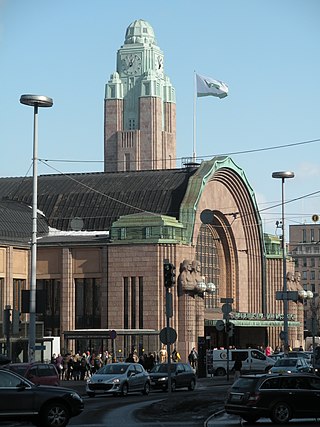
Helsinki Central Station (HEC) is the main station for commuter rail and long-distance trains departing from Helsinki, Finland. About 200,000 people "pass through the station" every day, half of whom are train passengers. The station serves as the terminus for all trains in the Helsinki commuter rail network, as well as for all Helsinki-bound long-distance trains in Finland. The Rautatientori metro station is located in the same building.

City-Center is a partly implemented plan to raze and rebuild the block between the central Helsinki streets of Kaivokatu, Keskuskatu and Aleksanterinkatu, creating a unified, modern appearance for the area. The plan was originally drafted between 1958 and 1960 by Viljo Revell; Heikki Castrén continued work on the plan after Revell's death in 1964. The fulfillment of the plan would have required the demolition of several old buildings that are today considered to be a vital part of Helsinki's heritage.

Aleksanterinkatu is a street in Kluuvi, the commercial centre of Helsinki, Finland. In the city plan by Carl Ludvig Engel, it was the Decumanus Maximus, the main east–west street in the city, crossing the Cardo, Unioninkatu (Union Street) at the corner of the Senate Square.
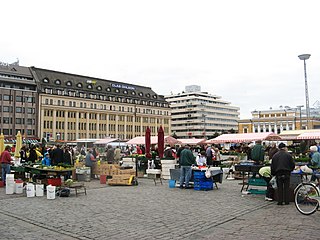
The Market Square is a city square in the city of Turku, in Finland. It is located in the city's VI District, and is generally considered the city's central square. It hosts a lively market on weekdays, and there are several cafés and restaurants on the square.
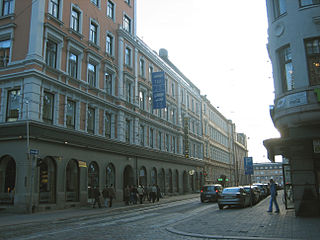
Kaisaniemi is a part of the centre of Helsinki, Finland, located immediately north of the Helsinki Central railway station and south of Hakaniemi. The most famous part of Kaisaniemi is the Kaisaniemi park, a park covering many hectares right in the city centre. Kaisaniemi is part of the Vironniemi district and neighbourhood of Kluuvi.

Accountor Tower is a high-rise office building, designed by architects Castrén–Jauhiainen–Nuuttila, located in the Keilaniemi district of Espoo, just outside Helsinki, the capital of Finland. With a height of 84 metres (274 feet), it is currently the fifth tallest habitable building in Finland, and was the tallest building in Finland from its construction in 1976 until 2006. Formerly known as the Fortum Head Office and before that Neste Tower, as of May 2018 it is the headquarters of the Nordic financial software company Accountor.

Hotel Kämp is a historic hotel in Kluuvi, Helsinki, Finland. It is a member of Leading Hotels of the World.
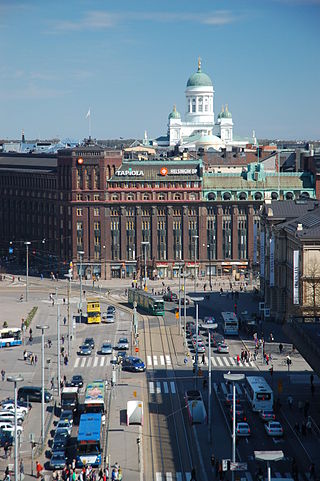
Kluuvi is the commercial centre of Helsinki, Finland, and a neighbourhood in the Vironniemi district of Helsinki. The Helsinki Central railway station, Hotel Kämp and Hotel Arthur, the Helsinki main post office, the Stockmann and Sokos department stores, the Kluuvi shopping centre and the main offices of Finnish banks are located in Kluuvi. Kluuvi includes the central campus of the University of Helsinki, the Ateneum art museum, and the movie theatres Maxim, Kinopalatsi and Bristol. The northeastern part of Kluuvi, which includes the Kaisaniemi park, is commonly called Kaisaniemi, but it is not the official name of any neighbourhood in Helsinki.

Stockmann Helsinki Centre is a culturally significant business building and department store located in the centre of Helsinki, Finland. It is one of many department stores owned by the Stockmann corporation. It is the largest department store in the Nordic countries in terms of area and total sales. The store is known for carrying all the internationally recognised luxury brands, and Stockmann's enjoys a reputation as the primary high-end department store in Finland. Stockmann Delicatessen, the food and beverage department located at the basement level, is renowned for the quality and choice of its foodstuffs. The Stockmann logo represents a set of escalators, which are commonly, but wrongly believed represent the first escalators in Finland. The first escalators in Finland were installed in the Forum department store, Turku (1926).
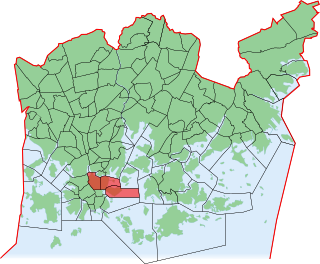
Vironniemi is a district of Helsinki, Finland, forming the core part of the city centre, thus also the central location of the Finnish governmental and financial decision making, and the location of Helsinki's most important churches. Vironniemi is the location of the Presidential Palace, the Palace of the Finnish Council of State, the Senate Square, the Helsinki Cathedral, the Uspenski Cathedral and the main office of the Bank of Finland.

Domus Litonii is a three-story Empire style residential, commercial and office building with a lower bazaar wing located at Aleksanterinkatu 50 in central Helsinki, Finland.

Keskuskatu, literally "Central Street", is a two block-long pedestrian street in the centrally-located Kluuvi neighborhood of Helsinki, Finland. Along the street are located : the Stockmann department store, the Rautatalo building, Domus Litonii, the World Trade Center and the Citycenter Mall, nicknamed "Makkaratalo". Keskuskatu begins at Pohjoisesplanadi, across from the Swedish Theatre, and ends when it meets Kaivokatu, across from Helsinki Central Station. It is intersected just south of its midpoint by Aleksanterinkatu.
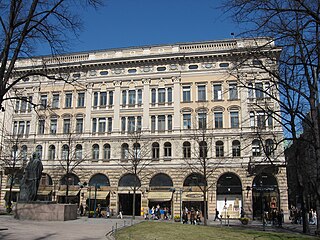
The Wrede passage, also known as the "Old merchant alley" or the "Grandma tunnel" is an entity formed by two stone buildings in Kluuvi, Helsinki, Finland. The name refers also to the merchant alley stretching throughout the block. The passage is formed by the Wrede house in the corner between Pohjoisesplanadi and Mikonkatu and the Central house in the corner between Aleksanterinkatu and Mikonkatu. The building entity represents Renaissance Revival architecture and was designed and partly commissioned by architect Karl August Wrede, and built in 1888 and 1892.

Mikonkatu is a street in central Helsinki, Finland, leading north from the Esplanadi Park to the Kaisaniemi Park, mostly converted into a pedestrian street in 1992.

Unioninkatu is one of the key streets in the historic centre of Helsinki, Finland. It stretches from the Tähtitorninvuori hill to the Pitkäsilta bridge and is about 1.5 km long. Its southern part is located in Kaartinkaupunki up to the Esplanadi park, while the northern part acts as the border between Kruununhaka to the east and Kluuvi to the west. The street functions as a local assembly street.





















